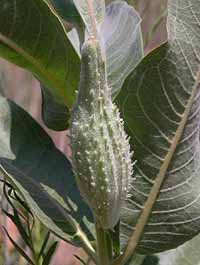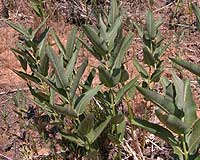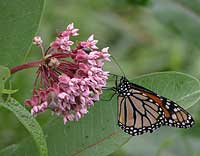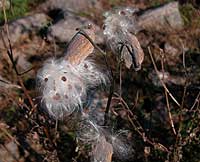
|
| Milkweed and pod. |

|
| Common Milkweed plants. |

|
| Flowering Milkweed with Monarch butterfly. |

|
| Milkweed pod with fluffy seeds. |
Asclepias syriaca L. (Asclepiadaceae)
Common Names
Common milkweed, common silkweed, cottonweed, milkweed, silkweed,
wild cotton, Virginia-silk, algodoncillo, silky
swallowwort, Seidenpflanze.
Description
Common milkweed (Asclepias
syriaca) is a perennial herb growing from a deep rhizome. The hairy
stems are usually solitary from a simple to branched and thickened base,
and are 6-20 dm (1.9-6.5 ft) tall. The opposite leaves have broadly
ovate to elliptic blades that are 10-20 cm (3.9-7.9 in) long and 5-11
cm (1.9-4.3 in) wide. The leaves are sparsely hairy above and densely
hairy below, and the petiole is 0.2-1.4 cm (0.08-0.77 in) long. The
inflorescence occurs in the upper leaf axils, and there are 20-130 flowers
per inflorescence. The flowers are small, 11-17 mm (0.4-0.7 in), and bloom
from May to August. The five petals are green to purple-tinged, and are
topped by a crown of five erect lobes that are rose to purple, rarely white.
The fruits are spindle-shaped follicles covered with soft hairs. The small,
round, hairy seeds are 6-8 mm (0.2-0.3 in) in diameter.
Uses
Warning: Milkweed may be toxic when taken internally, without
sufficient preparation.
Ethnobotanic: People have used milkweed for fiber, food, and medicine all over the United States and southern Canada. Milkweeds supply tough fibers for making cords and ropes, and for weaving a coarse cloth. Milkweed stems are collected after the stalks senesce in late fall-early winter. The dried stalks are split open to release the fibers; milkweed fibers are sometimes mixed with fibers of Indian hemp (Apocynum cannabinum). The bark is removed and the fibers released by first rubbing between the hands and then drawing the fibers over a hard surface.
Twisting the fiber opposite each other and twining them together forms the cord. Often this is accomplished by rolling the fibers on the thigh while twisting them together.
The young shoots, stems, flower buds, immature fruits, and roots of butterfly milkweed were boiled and eaten as a vegetable by various indigenous groups of eastern and mid-western America. The Meskwaki steam the flower buds as a food source; they are nutritious but not considered very flavorful.
The Cherokee drank an infusion of common milkweed root and virgin's bower (Clematis species) for backaches. The Cherokee, Iroquois, and Rappahannock used the sap to remove warts, for ringworm, and for bee stings. The Cherokee used the plant as a laxative, an antidote for gravel and dropsy, and an infusion was given for mastitis. The Cherokee took an infusion of the root for venereal diseases. The Chippewa made a cold decoction of common milkweed root and added it to food to produce postpartum milk flow. The Iroquois took an infusion of milkweed leaves for stomach medicine. A compound decoction of plants was taken to prevent hemorrhage after childbirth by the Iroquois. The Menominee ate the buds or a decoction of the root for chest discomfort. The Ojibwa used the root as a female remedy. The Potawatomi used the root for unspecified ailments.
Common milkweed was used by the Meskwaki as a contraceptive. A Mohawk anti-fertility concoction was prepared by boiling a fistful of dried, pulverized milkweed and three jack-in-the-pulpit rhizomes in a pint of water for 20 minutes. The infusion was drunk at the rate of one cup an hour to induce temporary sterility.
Milkweed species as a group are known to contain cardiac glycosides that are poisonous to humans and livestock, as well as other substances that may account for their medicinal effect. Resinoids, glycosides, and a small amount of alkaloids are present in all parts of the plant. Symptoms of poisoning by the cardiac glycosides include dullness, weakness, bloating, inability to stand or walk, high body temperature, rapid and weak pulse, difficulty breathing, dilated pupils, spasms, and coma.
Wildlife: The cardiac glycoside in milkweed has also been useful as a chemical defense for monarch butterflies (Danaus plexippus). Chemicals from the milkweed plant make the monarch caterpillar's flesh distasteful to most predators. Monarch butterflies are specific to milkweed plants; this is the only type of plant on which the eggs are laid and the larvae will feed and matures into a chrysalis. Eggs are laid on the underside of young, healthy leaves. Monarch, Queen, and Viceroy butterflies are Müllerian mimics; all are toxic, and have co-evolved similar warning patterns to avoid predation. Milkweed species are attractive to many insect species, including the large milkweed bug, common milkweed bug, red milkweed beetle, blue milkweed beetle, and bees. Accordingly, this is a wonderful horticultural plant for landscaping to attract butterflies (particularly monarchs), whose numbers are declining and migratory routes changing due to lack of appropriate habitat.
Establishment
Adaptation: Common milkweed grows in sandy, clayey, or rocky
calcareous soils. It occurs along the banks or flood plains of lakes,
ponds, and waterways, in prairies, forest margins, roadsides, and waste
places. This species hybridizes with showy milkweed (Asclepias speciosa).
Common milkweed is easily propagated by both seed and rhizome cuttings. Both seedlings and cuttings will usually bloom in their second year, although cuttings will occasionally bloom during their first year. Seeds and plants are available from many nurseries. Common milkweed increases by underground shoots and can be invasive. It is ideal in semi-dry places where it can spread without presenting problems for other ornamental species. Propagation from Cuttings: Propagation by cuttings of the tuberous rhizome is easy and reliable. The cuttings should be made when the plant is dormant. Each piece of the rhizome should have at least one bud (they are about two inches apart). Timing of propagation is important. Harvest or divide plants and get the plants in the ground by late fall so they can develop enough root growth to survive the winter. Irrigation the first year will improve survival, and by the second year the root system should be well enough established so plants will survive on their own. Both seedlings and cuttings will usually bloom in their second year, although cuttings will occasionally bloom during their first year. Propagation from Seed: Common milkweed is easily propagated from seed. Process as follows:
- Collect seeds after the pods have ripened, but before they have split open. The seeds are wind dispersed, so be careful when gathering to place in a paper or burlap bag to avoid losing them.
- Eliminate weeds before planting. Strip off any sod. Cultivate the soil to a fine tilth, firm the soil by treading or rolling, and rake lightly.
- Seeds can be directly sewn into the ground in the fall. Sow the seed mixture (with fine sand for even distribution) at a rate of 1/8 oz per sq. yd (4 g per sq. meter) or as advised.
- If planting in flats or in a greenhouse, common milkweed seeds should be cold-treated for three months.
- The seed is very viable. It is not certain how long you can store the seeds and maintain their viability.
- During the first summer, weed invasive plants and water as needed.